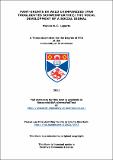Files in this item
Pant-grunts in wild chimpanzees (Pan troglodytes schweinfurthii): the vocal development of a social signal
Item metadata
| dc.contributor.advisor | Zuberbühler, Klaus | |
| dc.contributor.author | Laporte, Marion N.C. | |
| dc.coverage.spatial | 245 | en_US |
| dc.date.accessioned | 2011-08-12T13:58:11Z | |
| dc.date.available | 2011-08-12T13:58:11Z | |
| dc.date.issued | 2011-06-21 | |
| dc.identifier.uri | https://hdl.handle.net/10023/1973 | |
| dc.description.abstract | While the gestural communication of apes is widely recognised as intentional and flexible, their vocal communication still remains considered as mostly genetically determined and emotionally bound. Trying to limit the direct projections of linguistic concepts, that are far from holding a unified view on what constitute human language, this thesis presents a detailed description of the pant-grunt vocalisation usage and development in the chimpanzees (Pan troglodytes schweinfurthii) of the Budongo forest, Uganda. Pant-grunts are one of the most social vocalisations of the chimpanzee vocal repertoire and are always given from a subordinate individual to a dominant. The question of how such a signal is used and develops is critical for our understanding of chimpanzee social and vocal complexity in an ontogenetical and phylogenetical perpective. Results suggest that pant-grunt vocalisations can be used in a flexible way, both in their form and usage within a social group. More specifically, chimpanzees seemed to take into account the number and identity of surrounding individuals before producing these vocalisations. At the acoustic level, pant-grunts seem to be very variable vocalisations that corresponded to different social situations commonly encountered. Grunts are one of the first vocalisations produced by babies but they are not first produced in social contexts. Although some modifications of the social grunts form and usage could not entirely be attributed to maturation only, the role of the mother seemed to be restricted. Her direct influence was perhaps more visible in the rhythmic patterns of chorusing events. Taken together, this thesis suggests that chimpanzee vocalisations are more flexible in their usage, production and acquisition than previously thought and might therefore be more similar to gestural communication. | en_US |
| dc.language.iso | en | en_US |
| dc.publisher | University of St Andrews | |
| dc.rights | Creative Commons Attribution-NonCommercial-NoDerivs 3.0 Unported | |
| dc.rights.uri | http://creativecommons.org/licenses/by-nc-nd/3.0/ | |
| dc.subject | Communication | en_US |
| dc.subject | Chimpanzee | en_US |
| dc.subject | Vocal development | en_US |
| dc.subject | Vocalisation | en_US |
| dc.subject | Sociality | en_US |
| dc.subject | Pant-grunt | en_US |
| dc.subject | Flexibility | en_US |
| dc.subject.lcc | QL737.P96L27 | |
| dc.subject.lcsh | Chimpanzees--Vocalization | en_US |
| dc.subject.lcsh | Chimpanzees--Behavior | en_US |
| dc.subject.lcsh | Social behavior in animals | en_US |
| dc.title | Pant-grunts in wild chimpanzees (Pan troglodytes schweinfurthii): the vocal development of a social signal | en_US |
| dc.type | Thesis | en_US |
| dc.contributor.sponsor | EU FP6 Pathfinder initiative “what it means to be human” | en_US |
| dc.contributor.sponsor | Lucie Burgers Foundation for Comparative Behaviour Research, Arnhem, The Netherlands | en_US |
| dc.type.qualificationlevel | Doctoral | en_US |
| dc.type.qualificationname | PhD Doctor of Philosophy | en_US |
| dc.publisher.institution | The University of St Andrews | en_US |
This item appears in the following Collection(s)
Except where otherwise noted within the work, this item's licence for re-use is described as Creative Commons Attribution-NonCommercial-NoDerivs 3.0 Unported
Items in the St Andrews Research Repository are protected by copyright, with all rights reserved, unless otherwise indicated.


